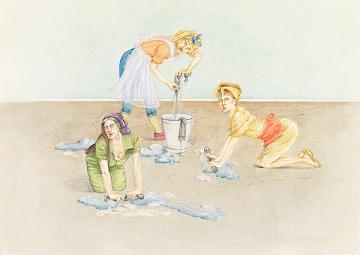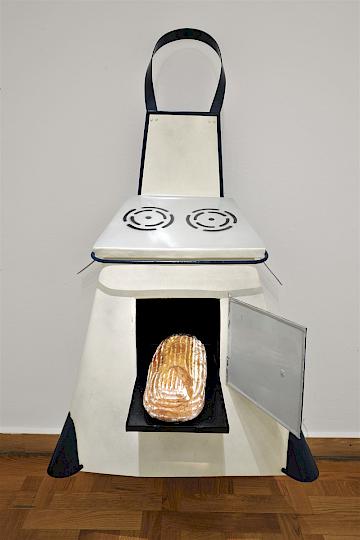'Everything flows, conditions and permeates itself ...' Felicitas Thun-Hohenstein in an interview with Birgit Jürgenssen
Felicitas Thun-Hohenstein: Performance is a genre which has become well established in different forms of artistic production, as well as in your own work. Experimenting with different media and techniques has always been an important aspect of your artistic practice, in order to get to the core of thing, as you say. Could you describe your initial approach to the medium performance and what would be a valid definition of this means of expression in your view?
Birgit Jürgenssen: To me performance means the possibility of putting a specific concern into artistic form, to show it and to evoke immediate reactions with its presentation. Isolation is the most terrible thing for me. Action or public performance is a communicative process, a process of learning. My first public performance was with the "Damen", with whom I collaborated between 1988 and 1994. I couldn't imagine doing public performances in the seventies, I was too shy. mehr
It seems to me that your early work was strongly formed by performative aspects. Do you agree?
Yes. The drawings, but of course also the photographs and objects resulted from private performances, which I then translated into the specific medium.
Could your drawings, photographs, and objects and their interaction be described as performative tools?
Absolutely. It has always been important to me to show the drawings and photographs together, which was a problem for a long time, since it took a long time until photography was acknowledged as an artistic form of production in Austria. The group exhibition curated by Valie Export 'Magna - Feminismus: Kunst und Kreativität'at the Galerie nächst St. Stephan in 1975 was my first opportunity to show my 'housewife' drawings (z402) together with my photographs and my 'Küchenschürze'' (s51)
together with my photographs and my 'Küchenschürze'' (s51) .
.
This exhibition is regarded as pioneer work in feminist communication strategies. Do you consider yourself a feminist artist?
Not within a categorization. I wanted to show current stereotypes and role models, which are attributed to woman in our society and which I have always been confronted with as well, and to point out the misunderstandings of everyday life. In the exhibition titled 'Wie erfährt man sich im Anderen,, das Andere in sich?' (how does one experience oneself in the other, the other in oneself?), at the gallery Hubert Winter in 1985, I summarized the basic intention of my work as dealing with a reflection of the outside perspective.
Your reflections are subversive acts of identity constructions. They refer to the socio-cultural entity and are political actions in an aesthetic framework. This becomes evident in the cutting self-ironic gesture, which is a central element of your work that compromises and deconstructs the patriarchal challenge very effectively.
I could quote a long list of reactions on the effectiveness of irony. 'Woman and irony' is still a taboo, just like 'woman and humour'. The price of an ironic gesture in the art world is to not be taken seriously for a long time. For me however, self-irony is an autobiographic strategy in order to communicate a subversive and deconstructive potential more easily.
Speaking of communication, to me you seem to be basically interested in showing the relationship of things, which you perceive as a pendulum between reality, illusion, and taboos, rather than as things themselves.
It was always challenging for me to make something fictional, irritating that goes beyond pure depiction. I started to deal with surrealistic literature and art at a very early point in my life and my pieces of work developed from the interplay between reading and every-day life. It was impossible for me to draw without having literature in my mind.
What you're describing is an inner dialogue that runs through your entire artistic production like a red thread or a constitutive element of connecting and networking strategies. Basically, the 'rhizomatic' quality of your work intentionally involves your viewers in a communicative process.
I think your 'spider model' is a pretty exact definition of my working method. I am not interested in depicting things themselves. Things only become exciting when the relations exiting between them move to the foreground.
In this sense, the 'Damen' can be seen as a group of female artists who wanted to start a communication process with their public actions.
In our actions we consciously engaged the audience as part of the piece, in order to go against an obvious understanding of portrayed contents and to give the actual, the other, a chance to exist. The audience was also challenged.
Did you have to cut back individual artistic positions in favour of the collective idea?
The 'Damen' were about communicating a collective statement, which required individual views to subordinate themselves to the intention of the collective. We also saw this as an alternative to the myth of the active male in art, a myth still cultivated today.
How would you evaluate the reception of female artists today in comparison to the seventies?
I think that female artists have only been noticed by critics since the development of computers and the boom of the music scene. Today, an ever-present problem is the fact that only certain social roles exist for female artists. A female artist is either accepted as a 'girl' or as a 'woman over sixty', the time in-between is hard work. My generation is between Elke Krystufek and Valie Export and doesn't fulfil expectations.
With your photographic self-analyses you started to involve your body in your work. Since the sixties the advancement to the surface of the artist's body has been an internationally known phenomenon. How would you define the social acceptance in Austria in this respect?
The topic was very much related to the art world, in other social areas it was either scandalized or ignored. Female performance artists in the United States were much more radical at that time. Their performances were much more professional. They constituted subjective actions, which didn`t just aim at breaking taboos, as it was the case in Austria. That is why the audience in this country has always felt the need to interfere.
In the seventies, the performance scene was very dense and comprised a lot more names than the ones known today.
Of course, but who understands the rules of history ... everything flows, conditions and permeates itself ...
Birgit Jürgenssen reacted as human being, artist, communicator, and corrective element in our society like few people have done before her. Despite the fact that she never really felt comfortable in this society, she was never infuriated by it, because nothing else could equally challenge her razor-sharp intellect. Birgit Jürgenssen died on September 25th 2003, in Vienna.